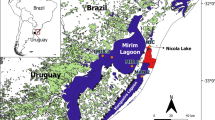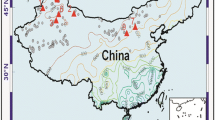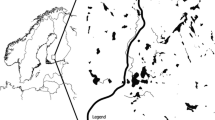Abstract
Wetlands have been identified as key elements of global carbon budgets. Today, due to increasing anthropogenic carbon emissions, the carbon storage capacity of these ecosystems has become of global interest. The focus of this research was to determine the storage capacity and mechanisms of carbon sequestration of Neotropical seasonal shallow lakes (SSLs), assessing their flood pulse, biomass, geomorphology and sediment composition. We applied a standardized and extensive sampling to five SSLs from the Colombian Orinoco-Llanos and five from the Brazilian Pantanal, during both flooded and non-flooded seasons. We found that sediment organic carbon (SOC) storage capacity in SSLs is significantly driven by the number of flooded days (p-value = 0.0057) rather than by their biomass production. The Orinoco-Llanos and Pantanal lakes differ in morphology, and thus in their inundation patterns. SSLs of the Orinoco-Llanos are more concave, having a significantly higher number of flooded days/year than SSLs from Pantanal. These hydrologic differences affect SOC storage, resulting in a significantly higher SOC storage in SSLs from Orinoco-Llanos than in Pantanal. A synopsis of data from both regions suggests the existence of a critical threshold between “non-flooded season losses” and “non-flooded season storage” of SOC in SSLs in a range of 225–275 flooded days/year.







Similar content being viewed by others

References
Adhikari S, Bajracharaya R, Sitaula B (2009) A review of carbon dynamics and sequestration in wetlands. Journal of Wetlands Ecology 2:42–46
Alho C, Sabino J (2012) Seasonal Pantanal flood pulse: implications for biodiversity. Oecologia Australis 16:958–978
Baldwin DS, Rees NG, Wilson JS, Colloff MJ, Whitworth KL, Pitman TL, Wallace TA (2013) Provisioning of bioavailable carbon between the wet and dry phases in a semi-arid floodplain. Oecologia 172(2):539–550
Barbosa RI, Silva dos Santos JR, Souza da Cunha M, Pena Pimentel T, Fearnside PM (2012) Root biomass, root: shoot ratio and belowground carbon stocks in the open savannahs of Roraima, Brazilian Amazonia. Australian Journal of Botany 60(5):405–416
Barker T, Maltby E (2009) Using wetland functioning. In: Maltby E, Barker T (eds) The wetlands handbook. Wiley-Blackwell, Oxford, pp 349–357
Botero P, Lopez D (1982) Los suelos de los Llanos Orientales. Suelos Ecuatoriales 12:18–26
Bullock JM (2006) Plants. In: Sutherland WJ (ed) Ecological census techniques: a handbook. Cambridge University Press, Cambridge, pp 186 –213
Couto EG, Oliveira VA (2011) The soil diversity of the Pantanal. In: Junk WJ, Nunes da Cunha C, da Silva CJ, Wantzen KM (eds) The Pantanal: ecology, biodiversity and sustainable management of a large neotropical seasonal wetland. Pensoft Publishers, Sofia, pp 71–102
Crawley MJ (2007) The R book. Wiley Publishing, Chichester
Escobar A, Gonzalez-Jimenez E (1976) Study of competitive consumption of large herbivores of the Lloodable Llano with special reference to the capibara (Hydrochoerus hydrochaeris). Agronomia Tropical 26:215–227
Fantin-Cruz I, Girard P, Zeilhofer P, Collischonn W, Nunes da Cunha C (2010) Meso-scale phytophysiognomic units in the Northern Pantanal and their relations with geomorphology. Biota Neotropica 10:31–38
Girard P, Nunes da Cunha C (1999) Relationship between surface and groundwater during the flood in the Brazilian Pantanal. Revista Boliviana de Ecología y Conservación Ambiental 6:33–40
Gorham E (1995) The biogeochemistry of northern peatlands and its possible responses to global warming. In: Woodwell GM, Mackenzie FT (eds) Biotic feedbacks in the global climatic systems. Oxford University Press, New York, pp 169–187
Greenwood JJD, Robinson RA (2006) Principles of sampling. In: Sutherland WJ (ed) Ecological census techniques: a handbook. Cambridge University Press, Cambridge, pp 11–86
Hamarashid NH, Othman MA, Hussain MAH (2010) Effects of soil texture on chemical compositions, microbial populations and carbon mineralization in soil. Egyptian Journal of Experimental Biology (Botany) 6(1):59–64
Hamilton SK, Lewis WM (1990) Basin morphology in relation to chemical and ecological characteristics of lakes on the Orinoco river floodplain, Venezuela. Archiv Fur Hydrobiologie 119:393–425
Hamilton SK, Sippel SJ, Melack JM (2004) Seasonal inundation patterns in two large savanna floodplains of South America: the Llanos de Moxos (Bolivia) and the Llanos del Orinoco (Venezuela and Colombia). Hydrological Processes 18:2103–2116
Heckman CW (1994) The seasonal succession of biotic communities in wetlands of the tropical wet-and-dry climatic zone I: Physical and chemical causes and biological effects in the Pantanal of Mato Grosso, Brazil. Internationale Revue der Gesamten Hydrobiologie 79:397–421
IPCC (2006) 2006 IPCC Guidelines for National Greenhouse Gas Inventories, Prepared by the National Greenhouse Gas Inventories Programme, Eggleston HS, Buendia L, Miwa K, Ngara T, Tanabe K (eds). Published: IGES, Japan
Irion G, Buchas H, Junk WJ, Nunes da Cunha C, De Morais JO, Kasbohm J (2011) Aspects of geological and sedimentological evolution of the Pantanal plain. In: Junk WJ, Nunes da Cunha C, da Silva CJ, Wantzen KM (eds) The Pantanal: ecology, biodiversity and sustainable management of a large neotropical seasonal wetland. Pensoft Publishers, Sofia, pp 47–70
Johnson MS, Couto EG, Pinto OB Jr, Milesi J, Santos Amorim RS, Messias IAM, Biudes MS (2013) Soil CO2 dynamics in a tree island soil of the Pantanal: the role of soil water potential. Plos One 8(6):e64874. doi:10.1371/journal.pone.0064874
Junk WJ (1997) General aspects of floodplain ecology with special reference to Amazonian floodplains. In: Junk WJ (ed) The Central Amazon Floodplain: ecology of a pulsing system. Springer, Berlin, pp 3–20
Junk WJ, Nunes da Cunha C (2012) Pasture clearing from invasive woody plants in the Pantanal: a tool for sustainable management or environmental destruction? Wetlands Ecology and Management 20:111–122
Junk WJ, Bayley PB, Sparks RE (1989) The flood pulse concept in river-floodplain systems. Canadian Special Publication of Fisheries and Aquatic Sciences 106:110–127
Junk WJ, Nunes da Cunha C, da Silva CJ, Wantzen KM (2011) The Pantanal: A large South American wetland and its position in limnological theory. In: Junk WJ, Nunes da Cunha C, da Silva CJ, Wantzen KM (eds) The Pantanal: ecology, biodiversity and sustainable management of a large neotropical seasonal wetland. Pensoft Publishers, Sofia, pp 23–44
Junk WJ, Wantzen KM (2004) The Flood Pulse Concept: new aspects, approaches, and applications—an update. In: Welcomme RL, Petr T (eds) Proceedings of the second international symposium on the management of large rivers for fisheries. FAO, Bangkok, pp 117–140
Keddy PA, Fraser LH, Solomeshch AI, Junk WJ, Campbell DR, Arroyo MTK, Alho CJR (2009) Wet and wonderful: the world’s largest wetlands are conservation priorities. Bioscience 59:39–51
Lemes do Prado A, Heckman CW, Martins FM (1994) The seasonal Succession of biotic communities in wetlands of the tropical wet-and-dry climatic zone II: the Aquatic macrophyte vegetation in the Pantanal of Mato Grosso, Brazil. Internationale Revue der Gesamten Hydrobiologie 79:397–421
Lenart M (2009) An unseen carbon sink. Nature Reports Climate Change 3:137–138
Maltby E (2009) The changing wetland paradigm. In: Maltby E, Barker T (eds) The wetlands handbook. Wiley-Blackwell, Oxford, pp 3–42
McClain ME (2001) The relevance of the biogeochemistry to Amazon development and conservation. In: McClain ME, Victoria R, Richey RE (eds) The biogeochemistry of the Amazon basin. Oxford University Press, New York, pp 2–16
Mitra S, Wassmann R, Vlek PLG (2005) An appraisal of global wetland area and its organic carbon stock. Current Science 88:25–35
Mitsch WJ, Bernal B, Nahlik AM, Mander U, Zhang L, Anderson CJ, Jorgensen SE, Brix H (2012) Wetlands, carbon, and climate change. Landscape Ecology 28:583–597
Mitsch WJ, Nahlik AM, Wolski P, Bernal B, Zhang L, Ramberg L (2010) Tropical wetlands: seasonal hydrologic pulsing, carbon sequestration, and methane emissions. Wetlands Ecology and Management 18:573–586
Mitsch WJ, Gosselink J (2007) Wetlands, 4th edn. John Wiley & Sons, New York
Moore TR, Dalva M (1997) Methane and carbon dioxide exchange potentials of peat soils in aerobic and anaerobic laboratory incubations. Soil Biology and Biochemistry 29:1157–1164
Nogueira F, Couto EG, Bernardi CJ (2002) Geostatistics as a tool to improve sampling and statistical analysis in wetlands: a case sudy on dynamics of organic matter distribution in the Pantanal of Mato Grosso, Brazil. Brazilian Journal of Biology 62:861–870
Novaes Filho JP (2012) Variabilidade de atributos do solo em um transecto entre os biomas Pantanal Mato-grossense e Cerrado. PhD Dissertation, Tropical Agriculture Programm, Federal University of Mato Grosso, FAMEV, Cuiabá, pp 299
Olson DM, Chernoff B, Burgess G, Davidson I, Canevari P, Dinerstein E, Castro G, Morisset V, Abell R, Toledo E (1998) Freshwater biodiversity of Latin America and the Caribbean: A conservation assessment. WWF-US, Wetlands International, Biodiversity Support Program, and USAID, Washington, DC, p 70
Penha JMF, da Silva CJ, Bianchini-Júnior I (1999) Productivity of the aquatic macrophyte Pontederia lanceolata Nvtt. (Pontederiaceae) on floodplains of the Pantanal Mato-grossense, Brazil. Wetlands Ecology and Management 7:155–163
Price PB, Sowers T (2004) Temperature dependence of metabolic rates for microbial growth, maintenance, and survival. Proceedings of the National Academy of Sciences of the United States of America 101:4631–4636
R Development Core Team (2013) R: A language and environment for statistical computing. R Foundation for Statistical Computing, Vienna, Austria. URL http://www.R-project.org/
Reddy KR, DeLaune RD (2008) Biogeochemistry of wetlands: Science and applications. CRC Press, Boca Raton
Regional Competitiveness Commission (2010) Plan de competitividad de Casanare. INCODER, Yopal, Colombia, p 60
Russi D, ten Brink P, Farmer A, Badura T, Coates D, Förster J, Kumar R, Davidson N (2013) The Economics of Ecosystems and Biodiversity for Water and Wetlands. IEEP, London and Brussels, Ramsar Secretariat, Gland, pp 77
San-Jose JJ, Montes RA, Mazorra MA, Aguirre Ruiz E, Matute N (2010) Patterns and carbon accumulation in the inland water-land palm ecotone (morichal) across the Orinoco lowlands, South America. Plant Ecology 206:361–374
San-Jose JJ, Montes RA, Farinas MR (1998) Carbon stocks and fluxes in a temporal scaling from a savanna to a semi-deciduous forest. Forest Ecology and Management 105:251–262
Schwendenmann L, Pendall E, Potvin C (2007) Surface soil organic carbon pools, mineralization and CO2 efflux rates under different land-use types in Central Panama. In: Tscharntke T, Leuschner C, Zeller M, Guhardja E, Bidin A (eds) The stability of tropical rainforest margins, linking ecological, economic and social constraints of land use and conservation. Springer Verlag, Berlin, pp 109–131
Smith LK, Lewis WM, Chanton JP, Cronin G, Hamilton SK (2000) Methane emissions from the Orinoco River floodplain, Venezuela. Biogeochemistry 51:113–140
van der Valk AG (2006) The biology of freshwater wetlands. Oxford University Press, New York
Wantzen KM, Couto EG, Mund EE, Amorim RSS, Siqueira A, Tielborger K, Seifan M (2012) Soil carbon stocks in stream-valley-ecosystems in the Brazilian Cerrado agroscape. Agriculture, Ecosystems & Environment 151:70–79
Wantzen KM, Nunes da Cunha C, Junk WJ, Girard P, Rossetto OC, Penha JMF, Couto EG, Becker M, Priante G, Tomas WM, Santos SA, Marta J, Domingos I, Sonoda F, Curvo M, Callil C (2008a) Towards a sustainable management concept for ecosystem services of the Pantanal wetland. Ecohydrology and Hydrobiology 8:77–100
Wantzen KM, Junk WJ, Rothhaupt KO (2008b) An extension of the floodpulse concept (FPC) for lakes. Hydrobiologia 613:151–170
Wantzen KM, Drago E, da Silva CJ (2005) Aquatic habitats of the Upper Paraguay River-Floodplain-System and parts of the Pantanal, Brazil. Ecohydrology and Hydrobiology 5:107–126
Williams DD (2006) The Biology of Temporary Waters. Oxford University Press, New York
Woomer PL, Martin A, Albrecht A, Resch DVS, Scharpenseel HW (1994) The importance and management of soil organic matter in the tropics. In: Woomer PL, Swift MJ (eds) The biological management of tropical soil fertility. John Wiley & Sons, Chichester
Zhang Y, Li CS, Trettin CC, Li H, Sun G (2002) An integrated model of soil, hydrology, and vegetation for carbon dynamics in wetland ecosystems. Global Biogeochemical Cycles 16:9–17
Zuur A, Ieno EN, Walker N, Saveliev AA, Smith GM (2009) Mixed effects models and extensions in ecology with R. Springer, New York
Acknowledgments
This research was partially supported by National Institute for Science and Technology of Wetlands (INCT-INAU), Brazil, German Academic Exchange Service (DAAD), State Law on Graduate Funding (LGFG), Germany, the Carbiocial project (www.carbiocial.de) and Idea Wild. We would like to thank the Pantanal Research Centre (CPP) and National Institute for Science and Technology of Wetlands (INCT-INAU) in Brazil, and Las Aguilas Ranch, Educational Institute of Cusiana (IEC) and University of Tropic, Casanare, in Colombia, for their logistical support. We express our gratitude to all field and laboratory assistants involved in this work, especially Abilio Moraes, Thayse M. Marestoni, and Sejana Arteaga in Brazil, and Ricardo Sá, Vicente Preciado, Ginna Cruz, Lukas de Ventura and Jennifer Ardila in Colombia. We thank a number of ranches: Retiro Novo, Aparecida, Oreana, and Paulo das Canoas in Brazil, and Cuernavaca, Arizona and Flor Amarillo in Colombia. We also thank Diego Orduz for kindly assisting us with designing illustrations and Luisa F. Ricaurte for her comments on the manuscript. Paper #2 of the UNESCO Chair on River Culture/Fleuve et Patrimoine.
Author information
Authors and Affiliations
Corresponding author
Rights and permissions
About this article
Cite this article
Vega, L.F., Nunes da Cunha, C., Rothaupt, KO. et al. Does Flood Pulsing Act as a Switch to Store or Release Sediment-Bound Carbon in Seasonal Floodplain Lakes? Case Study from the Colombian Orinoco-Llanos and the Brazilian Pantanal. Wetlands 34, 177–187 (2014). https://doi.org/10.1007/s13157-013-0495-9
Received:
Accepted:
Published:
Issue Date:
DOI: https://doi.org/10.1007/s13157-013-0495-9



